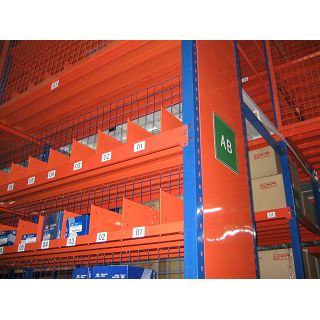Effectively laying out a large warehouse to accommodate different types of storage shelves involves careful planning and consideration of various factors. The goal is to maximize storage capacity, accessibility, and efficiency. Here are some steps to help you achieve an effective warehouse layout:
Assess Your Needs:
Start by assessing your storage needs, including the types of products you'll store, their size, weight, and any special requirements. This information will guide your layout decisions.
Categorize Items:
Categorize your inventory based on factors such as size, weight, fragility, and how often items are accessed. This will help you determine the best storage solutions for each category.
Choose the Right Shelving Systems:
Select shelving systems that are suitable for your products. This may include pallet racking, cantilever racks, bulk storage racks, mezzanine systems, or specialized storage options depending on the items to be stored.

Consider Accessibility:
Ensure that high-demand items are easily accessible. Place frequently accessed items in the most accessible areas, such as near the shipping and receiving area or close to the picking stations.
Optimize Vertical Space:
Make use of the vertical space in your warehouse by utilizing tall storage racks and mezzanine levels, especially if floor space is limited.
Create Aisles and Pathways:
Design clear aisles and pathways to facilitate the movement of equipment, employees, and forklifts. Ensure that aisles are wide enough to accommodate your equipment safely.
Use Warehouse Management Software:
Implement warehouse management software (WMS) to help track inventory, optimize picking routes, and manage storage locations more efficiently.
Zone Your Warehouse:
Divide your warehouse into zones based on the type of products or their storage requirements. This makes it easier to manage and locate items.
Implement Efficient Picking Strategies:
Consider batch picking, wave picking, or other efficient picking strategies to reduce travel time and improve order fulfillment.
Label and Mark Locations:
Clearly label and mark storage locations with barcodes, QR codes, or RFID tags. This helps with inventory management and reduces picking errors.
Safety Considerations:
Prioritize safety by ensuring that fire exits and emergency routes are clear, that racks are securely anchored, and that safety barriers are in place.
Plan for Growth:
Anticipate future growth and flexibility in your layout. Leave space for expansion or reconfiguration as needed.
Regular Maintenance:
Regularly inspect and maintain your storage systems to prevent damage, wear, and tear that can affect the layout's efficiency.
Employee Training:
Provide training for warehouse staff to ensure they are familiar with the layout, safety procedures, and the correct handling of items.
Continuous Improvement:
Continuously review and fine-tune your warehouse layout and processes to improve efficiency and adapt to changing needs.
It's essential to involve warehouse design experts or consultants, especially for large-scale projects, as they can provide valuable insights and expertise in optimizing the layout for your specific requirements. Additionally, consider the use of computer-aided design (CAD) tools to visualize and fine-tune your warehouse layout before implementing it.
The above is the analysis of storage shelf manufacturers, if you have any questions and needs, you can contact us! We will provide you with satisfactory warehouse and storage solutions.